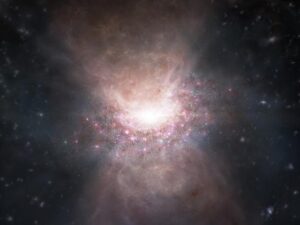
Gas dynamics are more than a little complicated no matter where you look. The dynamics of gas in and around forming galaxies makes is particularly complex.
Ideally… gas goes in and stays put.
But now we know that gas may sometimes go in… and shoot right out the other side.
And we now know that sometimes gas goes in, and the galaxy itself flings that gas back out.
Observers looking at the quasar J2054-0005 have found clear evidence that the system is flinging molecular gas – the stuff needed to form stars – out of the system.
While you likely aren’t noticing it right now, light exerts pressure. The more light hits you, your car, or the outer layers of a star or galaxy, the more push that light can exert. Our own Sun is a mostly spherical object because the inward pull of gravity is balanced against the outward push of light. (The Sun then gets a bit flattened because it’s rotating).
In galaxies with an actively feeding central black hole, material will form what’s called an accretion disk around the black hole, and that disk can get extremely hot and dense and generate a magnificent amount of light. This light makes quasars the quasi-stellar objects we know and love; that disk appears like a bright star, and it can be so bright that we don’t even see the surrounding galaxy.
And that light from that disk can exert a powerful force that pushes gas away, sending it streaming out of the system or so the theory has gone. We hadn’t exactly seen this happening… at least not until now.
Observers led by Dragan Salak used the Atacama Large Millimeter and submillimeter Array to observe the extremely bright quasar J2054-0005. This particular telescope system lets them see the absorption lines of different gasses in the bright rainbow of the galaxy’s overall continuum of light. In this case, they saw OH – the molecule hydroxide – flowing out of the system. This gas outside of the galaxy is gas that can’t turn into stars in the galaxy.
And thus, a theory is true. The tremendous light of a quasar’s accretion disk can expel gas and suppress star formation.
